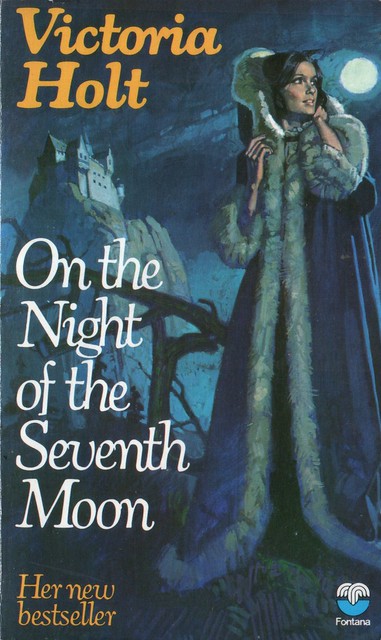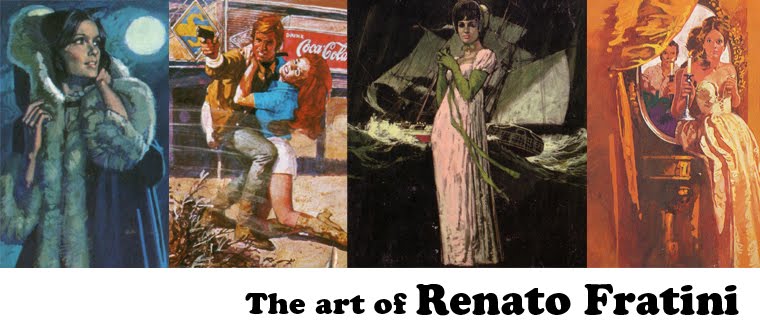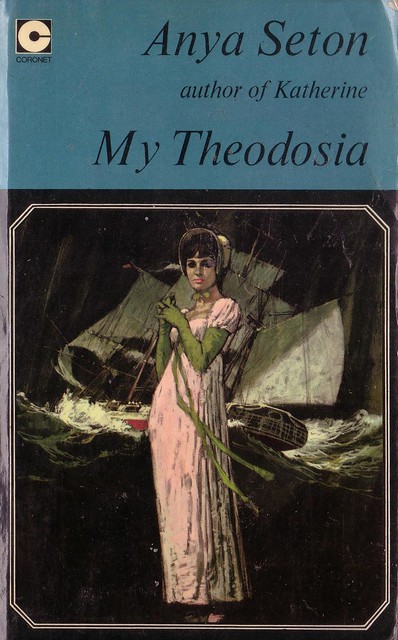Friday, August 30, 2013
Pulp Crush: Angelique and the Sultan by Sergeanne Golon. Heine...
Pulp Crush: Angelique and the Sultan by Sergeanne Golon. Heine...: Angelique and the Sultan by Sergeanne Golon. Heinemann 1961. Cover artist Renato Fratini , a photo by pulpcrush on Flickr.
Tuesday, June 4, 2013
Sunday, May 12, 2013
Why Renato Fratini?
Why Renato Fratini?
I could start this first post exploring who Renato Fratini was, delving into his childhood, his early studio days, how he came to the U.K., who he married etc... but I won't. It wasn't how it was for me when I first came across his artwork. The man whose artwork and illustrations graced hundreds of book covers and movie posters was a mystery for me for some time, almost two years. So I thought instead of covering off who he was, I'd look at how I came to discover this prolific and accomplished artist.
My passion for collecting vintage paperback books commenced almost two years ago, admittedly only initially focusing on the world of Science-Fiction. But before too long, it wasn't enough. The buzz of being able to delve into vast treasure troves of books at charity shops (often for only $10 for a large bag capable of carrying around 100 books - hey, I'd make 'em fit!) meant that in the immediate region, the stores and their sci-fi treasures were soon plundered. If I wasn't bringing home a haul of a couple of hundred books, I wasn't doing it right!
I wanted more. I needed more. I was bitten by a collecting bug that I'm glad hasn't really caught on widely as yet. The dusty paperback, with yellowed pages and dog-eared corners are not readily sought by the general public. Being a father also meant that I couldn't currently spend a lot on a hobby - instead of a single comic worth $150, I could buy several hundred paperback books and enjoy not only their cover art, I could in time read them (OK, maybe skip the romance titles) and also get to know the artists who created the works and share what I discover and learn with others.
I love the thrill of delving into thousands of cheap paperbacks - a quick glance of their spines and I can quickly discern if further investigation is warranted. Pan, Fontana, Sphere, Panther, Ballintine, Dell or the Australian pulp publishers such as Pacific or Horwitz - I know what I'm looking for. It's the thrill of the hunt of finding the familiar, but more than that, it's the thrill of the hunt of finding something new. That's what excites me. And sure, with almost 3000 books in my collection, I have my retirement reading set, but for now it's the thrill of the hunt for that next illustration that catches my eye, and with it a new illustrator to discover or add to the collection. A multiple of a past title in my collection may also upgrade a lesser grade on my shelves.
So it was that in an almost frenzied desperation I delved into the romance section of a large Salvos charity store. Brushing aside the modern covers that featured endless Fabio shots or purely just a title in some cursive script, I delved in initially as sometimes you could find a book that was misplaced by staff or (stashed) by customers. It wasn't long before I realised that I'd discovered a new wealth of illustration art - from historical covers and even the odd Mills & Boon, the covers arose with a startling similarity - cue the beautiful woman running screaming from a house, wearing only a nighdress - this appealed to me being a long time Hammer Horror fan - I'd discovered the "Gothic".
But it was this same fateful day that I discovered the work of an illustrator who's work immediately struck me as beautiful, dynamic and unique. Their work graced the covers for the romance authors Victoria Holt and Catherine Gaskin. I fell immediately for the illustrations before me. The style of these covers were similar, I was sure it was the work of the same artist, but I had no idea who the artist was as there was no signature and the publishers rarely placed the name of the artist on the cover or on the credits page.
Over time I would find more books with similarly crafted illustrations - adding fuel to the fire for me to want to find out who this artist was.. it was a matter of time. All I had to go by at the beginning of my quest was that the artist, he or she, worked for U.K. publisher Fontana in the late 1960s to early 1970s.
I could start this first post exploring who Renato Fratini was, delving into his childhood, his early studio days, how he came to the U.K., who he married etc... but I won't. It wasn't how it was for me when I first came across his artwork. The man whose artwork and illustrations graced hundreds of book covers and movie posters was a mystery for me for some time, almost two years. So I thought instead of covering off who he was, I'd look at how I came to discover this prolific and accomplished artist.
My passion for collecting vintage paperback books commenced almost two years ago, admittedly only initially focusing on the world of Science-Fiction. But before too long, it wasn't enough. The buzz of being able to delve into vast treasure troves of books at charity shops (often for only $10 for a large bag capable of carrying around 100 books - hey, I'd make 'em fit!) meant that in the immediate region, the stores and their sci-fi treasures were soon plundered. If I wasn't bringing home a haul of a couple of hundred books, I wasn't doing it right!
I wanted more. I needed more. I was bitten by a collecting bug that I'm glad hasn't really caught on widely as yet. The dusty paperback, with yellowed pages and dog-eared corners are not readily sought by the general public. Being a father also meant that I couldn't currently spend a lot on a hobby - instead of a single comic worth $150, I could buy several hundred paperback books and enjoy not only their cover art, I could in time read them (OK, maybe skip the romance titles) and also get to know the artists who created the works and share what I discover and learn with others.
I love the thrill of delving into thousands of cheap paperbacks - a quick glance of their spines and I can quickly discern if further investigation is warranted. Pan, Fontana, Sphere, Panther, Ballintine, Dell or the Australian pulp publishers such as Pacific or Horwitz - I know what I'm looking for. It's the thrill of the hunt of finding the familiar, but more than that, it's the thrill of the hunt of finding something new. That's what excites me. And sure, with almost 3000 books in my collection, I have my retirement reading set, but for now it's the thrill of the hunt for that next illustration that catches my eye, and with it a new illustrator to discover or add to the collection. A multiple of a past title in my collection may also upgrade a lesser grade on my shelves.
So it was that in an almost frenzied desperation I delved into the romance section of a large Salvos charity store. Brushing aside the modern covers that featured endless Fabio shots or purely just a title in some cursive script, I delved in initially as sometimes you could find a book that was misplaced by staff or (stashed) by customers. It wasn't long before I realised that I'd discovered a new wealth of illustration art - from historical covers and even the odd Mills & Boon, the covers arose with a startling similarity - cue the beautiful woman running screaming from a house, wearing only a nighdress - this appealed to me being a long time Hammer Horror fan - I'd discovered the "Gothic".
But it was this same fateful day that I discovered the work of an illustrator who's work immediately struck me as beautiful, dynamic and unique. Their work graced the covers for the romance authors Victoria Holt and Catherine Gaskin. I fell immediately for the illustrations before me. The style of these covers were similar, I was sure it was the work of the same artist, but I had no idea who the artist was as there was no signature and the publishers rarely placed the name of the artist on the cover or on the credits page.
 |
| Victoria Holt "On the Night of the Seventh Moon". Cover artist Renato Fratini |
Over time I would find more books with similarly crafted illustrations - adding fuel to the fire for me to want to find out who this artist was.. it was a matter of time. All I had to go by at the beginning of my quest was that the artist, he or she, worked for U.K. publisher Fontana in the late 1960s to early 1970s.
Subscribe to:
Posts (Atom)

